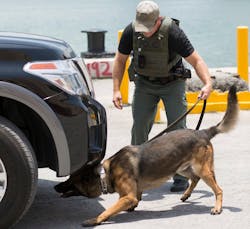For all the advancements made over the years in explosives detection technology, many of these solutions have not yet been able to replicate the accuracy nor the mobility of one of nature’s most powerful detection devices – the canine’s nose. Although bomb-sniffing dogs are considered an essential part of our nation’s fight against terrorism, many explosive detection canine teams across the country do not have easy access to the resources necessary to help keep them current with the latest knowledge and tactics.
However, the U.S. Department of Homeland Security (DHS) Science and Technology Directorate (S&T) recently created the Regional Explosives Detection Dog Initiative (REDDI) as part of an effort to identify various capability gaps and provide state and local law enforcement agencies with tools they need to stay ahead of the curve. The program is being assisted by researchers at Battelle, a non-profit charitable trust research and development organization that does contract research for commercial companies, as well as government agencies.
According to DHS S&T Detection Canine Program Manager Don Roberts, REDDI events feature a series of odor recognition trials for canine detection teams within very simplistic search scenarios, which enables them to determine where skills may need to be improved.
“We want to find out if their training aid list gives them the robustness to detect what we see as being potential emerging threats? Are they having issues with manufacturers of different explosives?” asks Roberts. “So, that’s what we mean by understanding capability gaps. Are they good at detecting what they’re trained to detect?”
Roberts says the other major piece of the REDDI program is seeing how bomb-sniffing dogs perform in a variety of operational environment tests.
“They do what they do normally. They search rooms, vehicles, open areas, and we setup certain problems, meaning we put an odor they are trained to detect in and around the searchable operational areas to see how they do and how they work,” he says. “We also uncover things like how a brand new team just out of training stacks up against experienced teams and things like that. It is the breadth of informing training better and making it more effective.”
According to Roberts, most explosive detection dogs work for praise or some kind of “play” reward and some even for a “food” reward but, in general, canines who work in this field are typically those that have a “high drive” and are “eager to please.” But that also has to be balanced in some of the operational areas these canines work in, which are in and around people.
“With explosive detection dogs, we feel it is one of the more challenging detection modalities. Dogs that may have too much drive for the explosive (detection) community could work in narcotics or drug detection, so CBP could potentially use them,” he says. “With the supply of canines, there are particular dogs that have certain traits that may not be good for an explosives dog but would be good for narcotics. Local law enforcement takes advantage of that and they try to be efficient with the dogs that are in the realm of potential use for them.”
Roberts says that many of the law enforcement agencies he’s interacted with as part of REDDI are looking for resources that can help them train more effectively and efficiently.
“It could be tools that the Department of Homeland Security Science and Technology Directorate have developed, such as non-hazardous canine training aids. These particular training aids are for explosives that they don’t normally get training on, so it allows them to have a tool that they can expose their canines to more often to maintain proficiency,” he explains. “It’s also just some of the techniques and best practices in becoming more robust in how they train. When a canine goes out to search an operational environment, we want them to be challenged and confirming that the only they’re sitting on is the explosive odor.”
Another part of this training initiative, according to Roberts, is to learn from other law enforcement agencies who have found success with particular methodologies. “Let’s say the LAPD is doing something with a particular training method that has really worked well for them, that could help us uncover how to help folks on the East Coast that may not be training with that method or employing that knowledge,” he adds.
Kevin Good, senior research scientist for Battelle, says that many of the men and women who serve as canine handlers are “hungry” for information and they have setup two different classroom modules as part of the REDDI program – one that is chemistry-focused and one that examines training and evaluation philosophies.
“I tell people all of that time that detection canine are a demonstrated effective resource. They are a proven entity,” Good says. “But there are ongoing efforts to better understand and improve that capability and that’s because today we face intelligent adversaries who continue to advance and alter their tactics, so the canine community must react and adapt as well.”
Roberts echoes Good’s sentiments and says that they are trying to stay ahead of terrorists who are constantly experimenting with different types of explosive materials and concealment methods, which is one of the driving factors behind REDDI. “We’re trying to be proactive in anticipating some of these evolving threats, which are using different variations of things already in our training kit, so we want to be able to say in addition to that, ‘Yeah, what we’re doing is effective in this changing threat environment,’” he says.
About the Author:
Joel Griffin is the Editor-in-Chief of SecurityInfoWatch.com and a veteran security journalist. You can reach him at [email protected].


